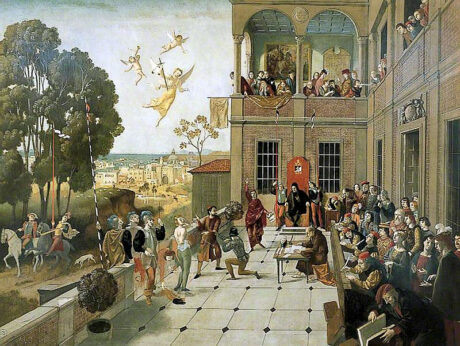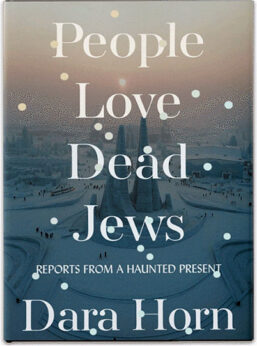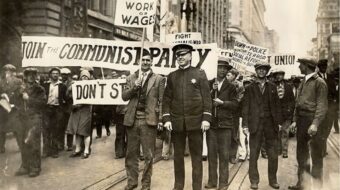
Dara Horn gave People Love Dead Jews: Reports from a Haunted Present an intentionally provocative title, and it worked. Her latest book won the National Jewish Book Award, the New York Times Notable Book of 2021, Chicago Public Library Best Book of the Year, Publishers Weekly Best Book of the Year, ALA Notable Book, Natan Notable Book, and was a Kirkus Prize finalist.
These essays touching on the overall theme—“reports,” with a more corroborated affidavit —were mostly published in other venues before coming together as a book of 12 fascinating, elegantly argued chapters.
Horn is also a fiction writer, with titles such as In the Image, The World to Come, All Other Nights, A Guide for the Perplexed, and Eternal Life. The literary magazine Granta has named her among the Best Young American Novelists. She has taught Hebrew and Yiddish literature at Harvard, Sarah Lawrence College, and Yeshiva University.
The book follows in the wake of horrific fatal attacks on synagogues and other Jewish locales (Pittsburgh, San Diego, New Jersey). But more than that, Horn tries to dissect why for many people around the world the strongest and most favored impressions they have of Jews are not of the ca. 15 million of us who are living today but of those millions killed in pogroms, the Holocaust, mass murders and isolated incidents, as well as of communities in any number of countries that have disappeared, leaving, in many cases, few remnants of their existence. It bears reminding readers that one of the great world religions—the largest in the U.S. and all the Western countries—is founded on the death and resurrection of one Jew.
What is “normal political concern?”
“Sometimes your body is someone else’s haunted house,” Horn begins. “Other people look at you and can only see the dead.” Much of the attention the world grants to Jews may seem benign and full of goodwill. “But as our current century wore on and public conversations about Israel became increasingly toxic—far beyond any normal political concern—and as public conversations about observant Jews took on the same tone, I came to recognize the mania for dead Jews as something deeply perverse.”
Right there in her Introduction she tips her hand that she does not see eye to eye with “toxic” criticism of the State of Israel, and presumes enough to pronounce what the limits of “normal” concern are—even though, contrary to the thesis of her book, that engagement with Israel is very much an issue not with the dead, but with living, breathing, present-day Jews.
In her chapter on Anne Frank, arguably the world’s second-most-famous dead Jew, Horn writes a blistering analysis of her attraction:
“The line most often quoted from Frank’s diary are her famous words, ‘I still believe, in spite of everything, that people are truly good at heart.’ These words are ‘inspiring,’ by which we mean that they flatter us. They make us feel forgiven for those lapses of our civilization that allow for piles of murdered girls—and if those words came from a murdered girl, well, then, we must be absolved, because they must be true. That gift of grace and absolution from a murdered Jew (exactly the gift that lies at the heart of Christianity) is what millions of people are so eager to find in Frank’s hiding place, in her writings, in her ‘legacy.’ It is far more gratifying to believe that an innocent dead girl has offered us grace than to recognize the obvious: Frank wrote about people being ‘truly good at heart’ before meeting people who weren’t. Three weeks after writing those words, she met people who weren’t.”
In her next chapter, Horn visits the Chinese city of Harbin, home of the annual Ice Festival. Turns out, this is a city that “was built by Jews.” Long story, which I won’t recount here, but it gives rise to another manifestation of her “dead Jews” fixation: the emergence of “Jewish Heritage Sites” as a lucrative concept for the tourist industry—“a much better name,” she writes, “than ‘Property Seized from Dead or Expelled Jews.’”
Stalin’s execution of leading Jewish intellectuals in 1952 remains a permanent blot on Soviet history. Horn devotes a chapter to it, comparing the way Jews in the USSR were forced to give up essential elements of their religion and traditions in order to “fit in,” much as the Jews in Jerusalem during the Hellenistic empire were also obliged, e.g., to give up circumcision if they were to compete in nude athletic games. “It doesn’t involve ‘intolerance’ or ‘persecution,’ at least not at first. Instead, it looks like the Jews themselves are choosing to reject their own traditions. It is a form of weaponized shame.”
The Soviets declared their formula as “not antisemitic, merely anti-Zionist” (Horn’s words), but that did not convince many people, especially—though Dr. Horn fails to mention it—since the USSR was the first nation in the world to recognize the new State of Israel in 1948. Soviet policy on the Jews had its own historically and culturally determined character, but in essence was the same as toward all the other nationalities, welcoming ethnic expression that was “national in form, socialist in content,” directed toward uprooting feudal and oppressive religious traditions in all those cultures. A modern society, which the USSR became in its 70 years, needed to leave the “shtetl” (of every culture, not just Jewish) behind, just as the United States, during the same period and still, has destroyed small-town farming and allowed a monopolistic agribusiness and extractive model to rule unchallenged in our rural states.
The defendants in the 1952 mock trials were later “rehabilitated,” but there was no real “Nuremberg” to assess accountability. Horn refers to “the Soviet Union’s destruction of Jewish culture” as an absolute, but that is simply not true. Yiddish publishing and theater returned, all under state control, of course, and religious observance also continued, so long as it did not promote Zionism. Some historians argue that the powerful movement to “free the Soviet Jews” in the 1970s and ’80s was one of the primary means for the West to finally delegitimize and ultimately dismantle the USSR.
Context
In a short, four-page chapter, “Dead American Jews, Part Two,” the writer responds to the two synagogue attacks, one in Poway, near San Diego, the other in Pittsburgh, that occurred during the Passover season of 2019. Horn ties her commentary to her understanding of the meaning of the Exodus from Egypt, of the very reason to celebrate Passover:
“The only purpose of this freedom is to enable the people to voluntarily accept divine laws—laws about welcoming strangers, loving one’s neighbors, and accepting responsibility for creating a civic society of mutual obligation. For a nation of former slaves, Jewish tradition teaches, this sudden new agency was dramatic, even terrifying…. [F]reedom is possible, but only with responsibility—and that freedom without responsibility is no freedom at all. People who hate Jews know this…. [U]nhinged killers feel entitled to freedom without any obligations to others. Antisemitism is at heart a conspiracy theory, and one appeal of conspiracy theories is that they absolve their believers of accountability, replacing the difficult obligation to build relationships with the easy urge to destroy.”
I wish I could take this at face value. It reads like a fifth-grade Sunday school lesson. Modern scholars, including Jews, doubt that the “Exodus” ever happened. The Passover story, a foundational myth for the Jewish people, seems to have evolved out of a need to explain (justify) the conquest by the Hebrew tribes of other tribes and nations in ancient Palestine such as the Canaanites. The 36-times-repeated admonition in the Bible to “welcome the stranger” is an appeal to the far greater non-Jewish world to welcome Jews wherever we wander—and also serves as a rabbinical warning that just in case, in anyone’s wildest imagination, Jews themselves should ever control their own state again, they too should remember this.

It was just this history come to pass that alarmed the Palestinian population, already in the 1920s or even earlier, that Jewish immigrants were buying up land, creating religiously separate communities (think kibbutzim), and eventually establishing a Jewish state that in its first days sent an estimated 750,000 Palestinians fleeing for their lives while establishing a racial “right of return” for Jews from anywhere on the planet willing to help build an occupier society that would become, year by year, settlement by settlement, war by war, border adjustment by border adjustment, more and more exclusively Jewish. Today you won’t even find a shadow of the “Green Line” (between Israel proper and the territories) on any official map.
It was just that history that resulted in the United Nations General Assembly Resolution 3379 of 1975, defining Zionism as a form of racism (revoked 16 years later, in 1991, tellingly once the Soviet Bloc was gone). Horn doesn’t speak, even once, about the State of Israel, the most visible expression of Jewish existence in the world, holding anyone accountable for any of its actions against the Palestinian population.
Nor has Horn any use for “all the tedious and self-serving explanations for why this scourge was apparently re-emerging in American life (Guns! Trump! Trolls! Twitter!)”—her emphasis—in a later chapter about the 2019 fatal attack on a kosher grocery store in Jersey City, “twenty minutes from my house.” She falls back on historical anti-Semitism popping its head up because memory of the Holocaust is dying off, and now, once again, “hating Jews was normal.” Apropos, I’d make the observation that in all the scary appeals I read from the Hillel international student organization or ADL concerning anti-Semitic activity on college campuses, Israel goes unmentioned, though I am convinced students are agitated about apartheid in Israel and the Occupied Territories and, uncritically, identifying any and all Jewish students with it. Now that something very close to a Jewish fascist government has been seated in Jerusalem, we can only expect worse to come.
Horn resents the media introducing “‘context’ (read: gaslighting)” as reporters try to understand why attackers would go after Hasidic Jews in Monsey, N.Y., attending a Hanukkah party. And of course, she is right: No one, for any reason, has the right to slash innocent people with machetes or stab them with knives or shoot them up with bullets. By comparison, she says, pundits did not investigate such “contexts” for the Charleston massacre of Black worshipers, the mass murder at Pulse, the gay nightclub in Orlando, or the Walmart massacre, targeting Latinos, in El Paso.
But the larger context is still out there, whether she chooses to wish it away or not, that are contributory factors to the violence of our society: poverty, displacement, gentrification, dispossession, racism, economic exploitation, ever-widening economic disparity, political corruption, disinvestment in schools, climate change whose effects fall disproportionately on despised communities and poor nations, Christian nationalism, a general sense of hopelessness and desperation. All prodded and poked, provoked and stoked by MAGA fascists eager to blame liberalism and Marxism, immigrants, Blacks, and queers for disturbing our beautiful Caucasian American peace and prosperity.
As Paul Krugman has written in the New York Times, “Most of us, I think, know that whenever bigotry runs free, we’re likely to be among its victims.”
It’s beyond axiomatic at this late stage to note that poor people, dispossessed people, historically oppressed people of color all over the world, empathize with the Palestinians and lament their fate. Since Israel identifies itself as a state of and for the Jewish people, inevitably Jews everywhere are sometimes going to pay the price for that pent-up frustration. For Israel denies the Palestinians any legitimate form of protest or resistance and even tries to criminalize their attempt to muster world opinion to their cause by such measures as boycott, divestment, and sanction. What pacific options are left?
Space does not permit deeper dives into some of her other chapters. One, “Fictional Dead Jews,” comments on the preponderance of the Holocaust as a fictional topic. She perceptively contrasts the tendency in Jewish literature to leave a story “without conclusions, but full of endurance and resilience,” as opposed to other narrative modes where the ending assumes there is some sense to be made of the world, some grace, epiphany, or redemption.
Her chapter on Varian Fry, the Holocaust rescuer of European writers, artists, and intellectuals, is her longest (58 pages) and perhaps most satisfying. She heralds those few individuals who saw and heard the evidence of mass murder early on and tried to warn the world, yet were thwarted by cowardly diplomacy, deep-seated anti-Semitism, and willful disbelief. Among her targets here is the writer Hannah Arendt—herself saved by Fry’s efforts—whose theory of how “banal” the actual praxis of Nazism and mass murder was to its perpetrators is adeptly contested. It’s here that she celebrates the prophetic role so few people play in any generation—and how ignored they are.
“Hath not a Jew eyes?”

Prof. Horn’s chapter on The Merchant of Venice is highly illuminating. Shakespeare’s portrayal of the Jew Shylock can only be read as anti-Semitic, yet for centuries scholars have sought mightily to find the Bard’s humanism in the story, while understanding the precarious position of Jews in Elizabethan England. The “context” seekers have long busied themselves trying to explain this play. In the moving speech that begins, “I am a Jew. Hath not a Jew eyes?” readers who want to exonerate the playwright, cite his universality.
Against her own wishes, but by demand from her 10-year-old son who insists on knowing what is meant by “a pound of flesh,” they listen to the play.
“‘… If you prick us,’” the actor reads in his famous soliloquy, “‘do we not bleed? If you tickle us, do we not laugh? If you poison us, do we not die? And if you wrong us, shall we not revenge?’”
“‘Wait,’” the son asks, “‘that’s the part where he’s more human?’”
“I hit Pause again. ‘Sure,’ I told my son, game-facing him back in the rearview. ‘He’s reminding us how he’s like everyone else. He’s a normal person with normal feelings.’
“My son laughed. ‘You seriously fell for that?’
“I swallowed, sickened. ‘What do you mean?’
“‘Shylock’s just saying he wants revenge! Like, “Oh yeah? If I’m a regular human, then I get to be eee-vil like a regular human!” This is the evil monologue thing that every supervillain does! “I’ve had a rough life and if you were me you would do the same thing, so that’s why I’m going to KILL BATMAN, mu-hahaha!” He’s just manipulating the other guy even more!’
“‘No, he’s—’ I fumbled, remembering the monologue’s final words: The villainy you teach me, I will execute; / and it shall go hard but I will better the instruction. For the first time, I heard the unspoken phrase that followed it: Mu-hahaha. I’d been trolled, betrayed, like Shylock at court.
“‘You’re not supposed to fall for the evil supervillain monologue! What idiot would fall for that?” [author’s emphasis in all places]
A false prophet?
And yet after that highly revealing analysis (emanating from a 10-year-old who’s clearly his mother’s son), Horn still doesn’t pause to wonder if the Holocaust fixation, the subsequent victorious hegemony of the Jewish settlement in Israel after the war irrespective of the indigenous Palestinian population’s rights and history, the ability of Jews—or anyone—to move en masse into villages or communities and supplant the local populace…if any of this might not be an expression of Jewish revenge for past crimes, visited upon people in Canaan, in Palestine, in Monsey, in New Jersey, wherever, who never invited them in, but all with a perfectly legal cover under the present order, except when some international body or organization momentarily calls Israel out for apartheid.
It’s these fault lines and blind spots, omissions and evasions in her argument that make Horn a false prophet. She is addicted to the particular as opposed to the universal. In alignment with the “lachrymose” version of Jewish historical experience, she has persuaded herself that Jews are “the world’s most consistently persecuted minority.” But it’s not a persecution sweepstakes, is it? She might get some healthy pushback on that from formerly colonized peoples around the world, from African Americans, certainly from Indigenous communities on every continent, and from rural folk displaced by the population explosion far into the cities’ exurbs. Especially if we interpret “consistent” not just in historicity but in gross numbers.
She has nothing useful left in her toolbox to offer but essentialist fear, trembling, and snide, unhelpful cynicism. Concerning the “context” of the attack on the Monsey Hasidim: “In other words, the cause of bloodthirsty antisemitic violence is…[sic] Jews, living in a place! Sometimes, Jews who live in places even buy land on which to live.… Predictably, this leads to sparring and flare-ups. Who wouldn’t express frustration with municipal politics by hacking people with a machete?” [author’s emphasis in both places]
Her warnings go unheeded, her cry in the wilderness unheard. Editors of prestigious newspapers don’t call upon her anymore, she laments, to offer insight and wisdom. Eventually, exhausted by the demands of motherhood and her professional career, and despairing of any change for the better, she retreats, in her concluding chapter, to embrace the worldwide movement of studying a page of Talmud every day, as pious Jews have done for a couple of thousand years. She admits it’s often far removed from the issues of our times—heated discussion about exactly how we determine the end of a day and when it is proper to light the Sabbath candles and other such precious nuances. She admits her solipsistic retreat as a kind of defeat: It is beyond her power to halt anti-Semitic attacks and so, escaping into the mysticism of nitpicking religious law, she abandons the cause.
But she never looks into the funding of anti-Semitic websites, media, organizations, or politicians, never steps back long enough to ask, Who benefits from anti-Semitism and other violent expressions of racism, from the divisiveness of ethnic strife, from senseless killing, from the ubiquity of guns? And is there more, or anything different, that Jews could be doing—everyone could be doing—to inform, educate, and most importantly, to find common cause together which will mitigate stereotypes and prejudice, show solidarity with other oppressed and hard-pressed people, and help identify and fight back against the fascist beast both at home and abroad? As the sage Hillel said, “If I am not for myself, who will be for me? And being [only] for myself, what am I? And if not now, when?”
 The time remaining before the MAGAts of the world, with or without Mr. Trump, utterly destroy democracy may be short. Rabbi Tarfon, who lived 2000 years ago, taught in a well-known saying from Pirke Aboth (“The Ethics of the Fathers”), “You are not required to finish your work, yet neither are you permitted to desist from it.”
The time remaining before the MAGAts of the world, with or without Mr. Trump, utterly destroy democracy may be short. Rabbi Tarfon, who lived 2000 years ago, taught in a well-known saying from Pirke Aboth (“The Ethics of the Fathers”), “You are not required to finish your work, yet neither are you permitted to desist from it.”
Amen. A luta continua. The struggle continues.
People Love Dead Jews
By Dara Horn
New York: W.W. Norton, 2021
268 pp., $17.95 paperback
ISBN: 978-1-324-03594-7










